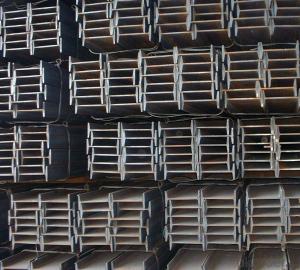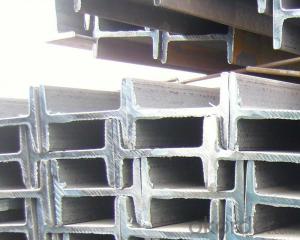Hot rolled H-section steel
- Loading Port:
- China Main Port
- Payment Terms:
- TT OR LC
- Min Order Qty:
- -
- Supply Capability:
- -
OKorder Service Pledge
OKorder Financial Service
You Might Also Like
I-steel beam (also known as English name I Beam), is the section shape of strip steel i-beam.I-steel divides ordinary I-beam and light I-beam, H type steel three. Is the type of groove shaped steel section shape.
Introduction
I-steel beam (also known as English name I Beam), is an H-shaped steel section. I-steeldivides ordinary I-beam and light I-beam, H type steel three. The I-shaped steel is widely used in various building structures, bridges, vehicles, bracket, machinery etc..
I-beam
The reason of ordinary I-beam wing root and light I-beam to the edge of the progressively thinner, has a certain angle, the ordinary I-beam and light I-beam model is the Arabia digitalwith the waist high cm number to represent, web, flange thickness and width of flange to the different specifications to waist high (H) x width (leg b) * waist thickness (d) without number representation, such as "general 160 x 88 x 6", namely said waist high of 160 mm 88 mm in width, legs, waist thickness of 6 mm is ordinary i-beam. / "light 160 x 81 x 5", namely said waistheight 160 mm, width of 81 mm legs, light I-beam waist thickness is 5 mm. Ordinary I-beamspecifications are available models said, type representation of waist high cm, such asgeneral 16#. Waist high same I-steel, if there are several different wide legs and waist thick,need to add a B C to be the difference in the types of the right, such as general 32#a, 32#b,32#c etc.. Hot rolled ordinary I-beam specifications for 10-63#. Hot rolled ordinary I-beamspecifications of both sides of supply and demand supply for 12-55# protocol.
Ordinary steel
The basic difference
I-beam are divided into ordinary I-beam, light I-beam and H type steel three.
Ordinary I-beam, light I-beam flanges on the web is variable cross section of thick, outer thin;H type steel: HW HM HN HEA HEB flange HEM I-beam is uniform
Ordinary I-beam, light I-beam has formed the national standard, the common 10# I-beamequivalent to the international I100 (such as the 10# channel also equivalent to channel(U100) for countries to implement different standards, resulting in subtle differences in their specifications)
H sections are also called the wide flange steel, HW HM HN derived from the European standard, HEB is the German standard I-beam, where HW, HN I-steel has been widely used in our country and production. HEA HEB HEM seen in many German design will, in the domestic market is also very difficult to buy. In the domestic steel structure engineering, if less, you can use the other specifications of steel plate welding assembled. And a large quantity of words,usually consider the use of mechanical properties and equivalent HW, HN type steel instead of.
HW I-beam is mainly used for reinforced concrete frame column steel column, also known asreinforced steel column; in the steel structure is mainly used for the column
HM type steel height and width of flange is roughly 1.33~~1.75 used for steel frame columnsin frame structure under dynamic load is used for the main frame beam in steel structure; for example: equipment platform
HN type steel height and flange width ratio is greater than or equal to 2; mainly used for beam
Use ordinary I-beam equivalent to HN steel;
The I-shaped steel whether ordinary or light, because the section size are relatively high,narrow, so the moment of inertia of the cross-section of two spindle difference, therefore, can only be used directly in the web plane bending component or its component lattice stress components. The axial compression member or in the perpendicular to the web plane and curved components are not used, thus in their application range is limited.
The H steel is efficient and economic cutting surface profile (there are other cold-formed steel, steel etc.), owing to the section shape is reasonable, they can make the steel higher effectiveness, improve the bearing capacity. Different from the ordinary I-shaped flange type H steel was widened, and the internal and external surface is usually parallel, which can facilitate the connection with high strength bolts and other components. Its size to form a series of reasonable, model complete, easy to use design.
The scope of application
Ordinary I-beam, light I-beam, because the section size are relatively high, narrow, so themoment of inertia of the cross-section of two main sleeve difference, thus in their applicationrange is limited. The I-steel should be based on the requirements of design drawings for choice.
The size design
H steel is efficient and economic cutting surface of steel (there are other cold-formed steel,steel etc.), owing to the section shape is reasonable, they can make the steel higher effectiveness, improve load ability. Different from the ordinary I-beam is flange type H steelwas widened, and the inner and the outer surface is usually parallel, which can facilitate theconnection with high strength bolts and other components. The composition of a reasonablesize, model complete, easy to use design.
In structure design, selection of I-beam should be based on its mechanical properties,chemical properties, weldability, structure size and the reasonable choice of the I-beam touse.
Welding process
Flange type H steel are of equal thickness, a rolling section, there are composite section is composed of 3 blocks of plate welding composition. Ordinary I-beam are rolling section,because of the production process is poor, the flange edge 1:10 slope. H type steel rolling is different from ordinary I-beam with only one set of horizontal roll, because of its wide flangeand no inclination (or slope is very small), so it will be a group of vertical roll at the same timerolling, therefore, the rolling technology and equipment than the conventional mill complex.The maximum rolling H steel of domestic production can be the height of 800mm, more thanonly welding composite section.
- Q:How do steel I-beams handle extreme temperatures?
- Steel I-beams are designed to handle extreme temperatures quite well. The high melting point of steel allows these beams to maintain their structural integrity even in extremely hot conditions. Additionally, steel has a low coefficient of thermal expansion, meaning it expands and contracts minimally with temperature changes, reducing the risk of cracking or warping. Overall, steel I-beams are a reliable choice for structures exposed to extreme temperatures.
- Q:What are the different methods of protecting steel I-beams from moisture or water damage?
- There are several methods to protect steel I-beams from moisture or water damage. One common approach is to apply a waterproof coating or paint on the surface of the beams, which forms a protective barrier against moisture. Another method is to use corrosion-resistant materials, such as stainless steel or galvanized steel, for the I-beams to prevent water damage. Additionally, proper insulation and ventilation systems can be installed to minimize condensation and moisture accumulation on the beams. Regular inspections and maintenance, including sealing any cracks or gaps, can also help protect the steel I-beams from water damage in the long run.
- Q:Can steel I-beams be used in historical building preservation projects?
- Yes, steel I-beams can be used in historical building preservation projects. They offer structural support and can help strengthen the building's framework without compromising its historical integrity. However, it is important to consider the specific requirements and guidelines of the preservation project to ensure that the use of steel I-beams aligns with the goals and objectives of preserving the historical building.
- Q:Can steel I-beams be used in renovation or retrofitting projects?
- Yes, steel I-beams can be used in renovation or retrofitting projects. They are commonly used for structural support and can be an effective solution when reinforcing or upgrading existing buildings or structures. Steel I-beams provide strength and stability, making them suitable for various renovation and retrofitting applications.
- Q:Can steel I-beams be used for cryogenic applications?
- Yes, steel I-beams can be used for cryogenic applications. Steel is known for its excellent strength and durability, making it a suitable material for various industrial applications, including cryogenic environments. However, it is important to note that the specific type of steel used must be selected carefully to ensure it can withstand the extreme temperatures and potential brittle fracture that can occur in cryogenic conditions. Additionally, proper insulation and design considerations should be taken into account to minimize heat transfer and prevent thermal stress on the steel beams.
- Q:How do you calculate the moment due to axial load in a steel I-beam?
- To calculate the moment due to axial load in a steel I-beam, you need to multiply the axial load by the distance from the centroid of the section to the point where the moment is being measured. This product gives you the moment caused by the axial load.
- Q:How are steel I-beams sized and classified?
- Steel I-beams are sized and classified based on their dimensions, particularly their depth, width, and weight per foot. The size and classification of steel I-beams are determined by industry standards and specifications, such as the American Institute of Steel Construction (AISC) standards. These standards ensure that I-beams are designed and manufactured to support specific loads and structural requirements.
- Q:Can steel I-beams be used in industrial facilities?
- Indeed, industrial facilities can utilize steel I-beams. Steel I-beams find frequent employment in the erection of industrial edifices and facilities owing to their robustness, resilience, and adaptability. These beams possess the ability to bear substantial loads and ensure structural steadiness, rendering them an optimal choice for industrial scenarios entailing support for heavy machinery, equipment, and materials. Furthermore, steel I-beams can be effortlessly manufactured and tailored to meet the precise demands and specifications of an industrial facility, thus garnering popularity within the construction sector.
- Q:Can Steel I-Beams be used for modular construction?
- Yes, Steel I-Beams can be used for modular construction. They are commonly used in modular construction due to their strength, durability, and ability to support heavy loads. Steel I-Beams provide structural stability and are often used as a framework for modular buildings.
- Q:How are steel I-beams used in construction?
- Steel I-beams are commonly used in construction as structural support elements. They are characterized by their distinctive I shape, which allows them to bear heavy loads over long spans. I-beams are positioned horizontally and are often integrated into the framework of buildings, bridges, and other structures to provide strength and stability. They can support walls, floors, roofs, and even entire buildings, making them an essential component in the construction industry.
1. Manufacturer Overview |
|
|---|---|
| Location | |
| Year Established | |
| Annual Output Value | |
| Main Markets | |
| Company Certifications | |
2. Manufacturer Certificates |
|
|---|---|
| a) Certification Name | |
| Range | |
| Reference | |
| Validity Period | |
3. Manufacturer Capability |
|
|---|---|
| a)Trade Capacity | |
| Nearest Port | |
| Export Percentage | |
| No.of Employees in Trade Department | |
| Language Spoken: | |
| b)Factory Information | |
| Factory Size: | |
| No. of Production Lines | |
| Contract Manufacturing | |
| Product Price Range | |
Send your message to us
Hot rolled H-section steel
- Loading Port:
- China Main Port
- Payment Terms:
- TT OR LC
- Min Order Qty:
- -
- Supply Capability:
- -
OKorder Service Pledge
OKorder Financial Service
Similar products
New products
Hot products
Hot Searches
Related keywords




























